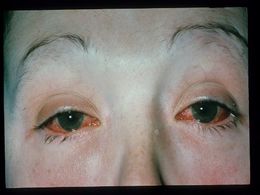Reactive Arthritis
Original Editors - Jennifer Colgan from Bellarmine University's Pathophysiology of Complex Patient Problems project. Top Contributors - Jennifer Colgan, Meredith Alvey, Admin, Kim Jackson, Vidya Acharya, Elaine Lonnemann, Lucinda hampton, Rucha Gadgil, 127.0.0.1, Megan Sarason, Wendy Walker, Claire Knott and Carina Therese Magtibay
Definition/Description[edit | edit source]
Reiter’s Syndrome is reactive arthritis that develops in response to an infection and characterized by a triad of arthritis, conjunctivitis, and nonspecific urethritis. It is considered an autoimmune disease marked by inflammatory synovitis and erosion at the insertion sites of ligaments and tendons. It commonly occurs after the presence of venereal disease process or enteric infection.[1][2][3]
Prevalence[edit | edit source]
Prevalence is difficult to establish due to lack of consensus regarding diagnostic criteria, the nomadic nature of the young target population, the under reporting of venereal disease, and the asymptomatic or milder course in affected women. [1]
Literature suggests that Reiter's Syndrome is more commonly seen in males, but recent studies suggest that the incidence in women is potentially underestimated. Women's symptoms tend to be less severe than men and women are prone to genitourinary diseases often causing a misdiagnosis. [1]
Individuals with the HLA-B27 genetic marker have an increased risk for developing Reiter's Syndrome following sexual contact or exposure to a bacterial infection. This history of infection (enteric or venereal) further increases the risk of developing Reiter's Syndrome. There is a strong prevalence of Reiter's Syndrome in individuals with HIV. The literature states that in patient's who are HIV positive, Reiter's Syndrome is more strongly correlated with male homosexuality than it is with people who have a history of injection drug use or other risky behaviours.[1][2]
Clinical Characteristics/ Clinical Presentation[edit | edit source]
Urethritis, conjunctivitis, and arthritis are the three symptoms classically associated with Reiter’s Syndrome[1], [4], [2]. Urethritis discharge is intermittent and may be asymptomatic. Conjunctivitis is usually minimal. The arthritis is usually asymmetrical and polyarticular occurring in the large joints of the lower extremities, including the knees, ankles, and 1st metatarsophalangeal. In some cases, hand joints may be involved. Individuals can also present with fungal infections (uveitis, keratitis) of the cornea.[1]
Individuals can present with three musculoskeletal manifestations including acute inflammatory arthritis, inflammatory back pain, and enthesitis (inflammation of the tendon at its insertion onto bone). It is uncommon for all three musculoskeletal manifestations to present at one time. Enthesitis most commonly occurs at the insertion of the Achilles tendon onto the calcaneus causing heel pain. Enthesitis may also occur at the ischial tuberosity, iliac crest, tibial tuberosity, and ribs, with patient complaints of musculoskeletal pain at these sites. It is imperative that a complete and thorough history should be done on these patients during their initial evaluation to rule out presence of Reiter's Syndrome.[1][5]
Reiter's Syndrome can have integumentary manifestations similar to psoriasis, a condition that causes dry, erythematous skin lesions that can occur in small patches or cover large surfaces. It commonly involves the toes, nails, and soles of feet.[5]
The initial illness typically resolves in 3-4 months, however, 50% of patients experience reoccurrence of symptoms and components of the syndrome over a period of years. Joint deformity and ankylosis, as well as sacroiliitis and spondylitis, may occur with chronic or recurrent RS. [2]
References[edit | edit source]
- ↑ 1.0 1.1 1.2 1.3 1.4 1.5 1.6 Goodman CC, Fuller KS. Pathology Implications for the Physical Therapist. 3rd ed. St. Louis, MO: Saunders Elsevier; 2009.
- ↑ 2.0 2.1 2.2 2.3 Porter RS, Kaplan JL. The Merck manual of diagnosis and therapy. Merck Sharp & Dohme Corp.; 2011.
- ↑ Kasper DL, Braunwald E, Fauci AS, Hauser SL, Longo DL, Jameson JL. Harrison's Manual of Medicine. 16th ed. McGraw-Hill, 2005
- ↑ Developed by R. Reiter's Syndrome. CRS - Adult Health Advisor [serial on the Internet]. (2009, July), [cited April 5, 2010]; 1. Available from: Health Source - Consumer Edition.
- ↑ 5.0 5.1 Goodman C, Snyder T. Differential Diagnosis for Physical Therapists: Screening for Referral, 5th ed. St. Louis, Missouri: Elsevier; 2013.
- ↑ Reiter Syndrome Health Byte LIVESTRONG.COM Available at https://www.youtube.com/watch?time_continue=3&v=mjLvaP82BHo








